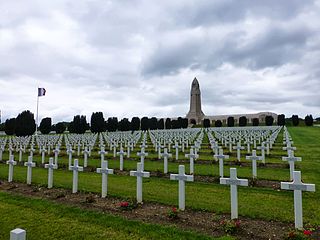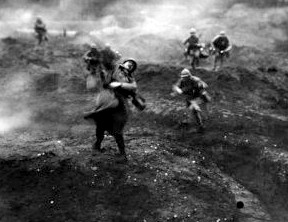 W
WThe Battle of Verdun, was fought from 21 February to 18 December 1916 on the Western Front in France. The battle was the longest of the First World War and took place on the hills north of Verdun-sur-Meuse. The German 5th Army attacked the defences of the Fortified Region of Verdun and those of the French Second Army on the right (east) bank of the Meuse. Using the experience of the Second Battle of Champagne in 1915, the Germans planned to capture the Meuse Heights, an excellent defensive position with good observation for artillery-fire on Verdun. The Germans hoped that the French would commit their strategic reserve to recapture the position and suffer catastrophic losses at little cost to the Germans.
 W
WThe Battle of Verdun, was fought from 21 February to 18 December 1916 on the Western Front in France. The battle was the longest of the First World War and took place on the hills north of Verdun-sur-Meuse. The German 5th Army attacked the defences of the Fortified Region of Verdun and those of the French Second Army on the right (east) bank of the Meuse. Using the experience of the Second Battle of Champagne in 1915, the Germans planned to capture the Meuse Heights, an excellent defensive position with good observation for artillery-fire on Verdun. The Germans hoped that the French would commit their strategic reserve to recapture the position and suffer catastrophic losses at little cost to the Germans.
 W
WThe Battle of Verdun, was fought from 21 February to 18 December 1916 on the Western Front in France. The battle was the longest of the First World War and took place on the hills north of Verdun-sur-Meuse. The German 5th Army attacked the defences of the Fortified Region of Verdun and those of the French Second Army on the right (east) bank of the Meuse. Using the experience of the Second Battle of Champagne in 1915, the Germans planned to capture the Meuse Heights, an excellent defensive position with good observation for artillery-fire on Verdun. The Germans hoped that the French would commit their strategic reserve to recapture the position and suffer catastrophic losses at little cost to the Germans.
 W
WFort Douaumont was the largest and highest fort on the ring of 19 large defensive works which had protected the city of Verdun, France since the 1890s. By 1915, the French General Staff had concluded that even the best-protected forts of Verdun could not resist bombardments from the German 420 mm Gamma guns. These new super-heavy howitzers had easily taken several large Belgian forts out of action in August 1914. Fort Douaumont and other Verdun forts were judged ineffective and had been partly disarmed and left virtually undefended since 1915. On 25 February 1916, Fort Douaumont was entered and occupied without a fight by a small German raiding party comprising only 19 officers and 79 men. The easy fall of Fort Douaumont, only three days after the beginning of the Battle of Verdun, shocked the French Army. It set the stage for the rest of a battle which lasted nine months, at enormous human cost. Douaumont was finally recaptured by three infantry divisions of the Second Army, during the First Offensive Battle of Verdun on 24 October 1916. This event brought closure to the battle in 1916.
 W
WThe Douaumont ossuary is a memorial containing the skeletal remains of soldiers who died on the battlefield during the Battle of Verdun in World War I. It is located in Douaumont, France, within the Verdun battlefield. It was built on the initiative of Charles Ginisty, Bishop of Verdun. It has been designated a "nécropole nationale".
 W
WFleury-devant-Douaumont is a commune in the Meuse department in Grand Est in north-eastern France.
 W
WThe heights of Le Mort Homme or Dead Man's Hill lie within the French municipality of Cumières-le-Mort-Homme around 10 km (6 mi) north-west of the city of Verdun in France. The hill became known during the Battle of Verdun during the First World War as the site of much fighting.
 W
W"They shall not pass" is a slogan used to express determination to defend a position against an enemy.
 W
WFort Vaux, in Vaux-Devant-Damloup, Meuse, France was built from 1881–1884 for 1,500,000 Francs and housed a garrison of 150 men. Vaux was the second fort to fall in the Battle of Verdun after Fort Douaumont which was captured by a small German raiding party in February 1916, in the confusion of the French retreat from the Woëvre plain. Vaux had been modernised before 1914 with reinforced concrete top protection like Fort Douaumont and was not destroyed by a German heavy artillery fire, which had included shelling by 16-inch howitzers. The superstructure of the fort was badly damaged but the garrison, the deep interior corridors and stations were intact when the fort was attacked on 2 June by German troops.
 W
WThe Verdun Memorial is a war memorial to commemorate the Battle of Verdun, fought in 1916 as part of the First World War. It is situated on the battlefield, close to the destroyed village of Fleury-devant-Douaumont in the département of Meuse in north-eastern France.
 W
WVerdun: Visions of History is a 1928 French docudrama film directed by Léon Poirier. It portrays the battle of Verdun, primarily by recreating the battle on its location, but also with the use of newsreel footage and dramatic scenes. Most of the people in the film are actual French and German World War I veterans, including Marshal Philippe Pétain who portrays himself. The film has a pacifist message.